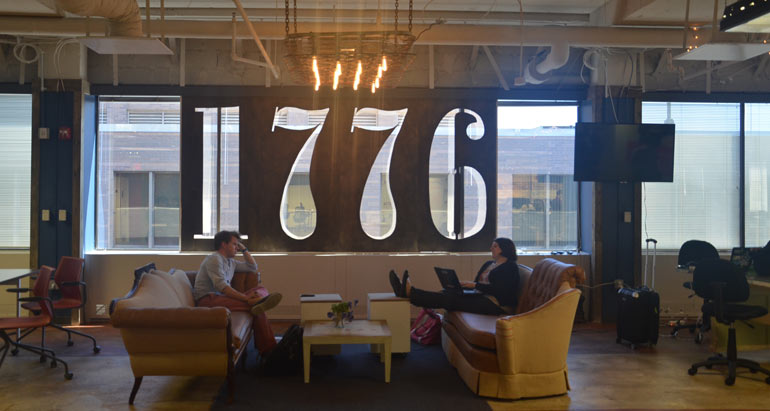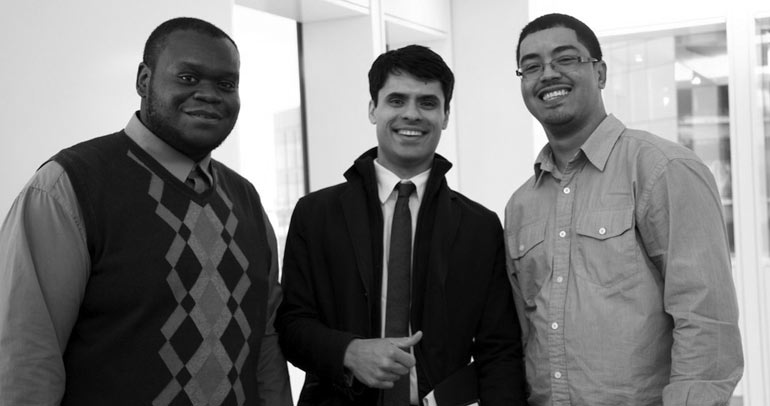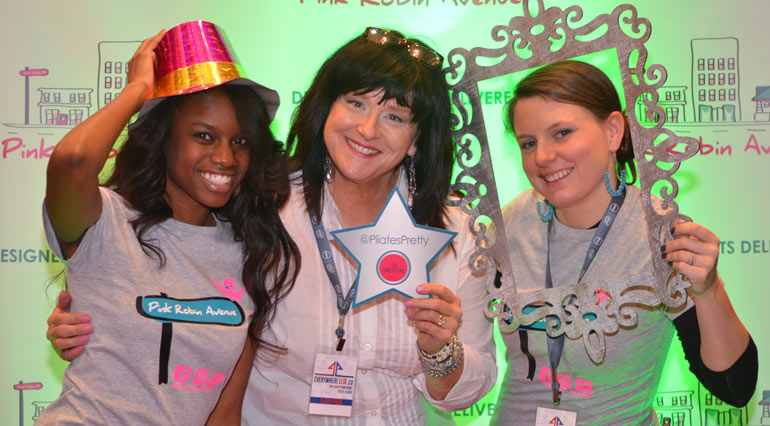Tables Turn As Accelerators Pitch At National Accelerator Demo Day
Last week 16 startup accelerators from across the country took the stage at Washington DC’s 1776 coworking space, incubator and home to the Fort Accelerator.
Ark Challenge (AR), Socratic Labs (NY), BetaSpring (RI), The Idea Village (Louisiana), Village Capital (GA), Points of Light Civic Accelerator (GA), Venture Hive (FL), Capital Factory (TX), Alpha Lab (PA), MassChallenge (MA), VentureSpur (OK), Brandery (OH), New York Digital Health Accelerator (NY), Springboard Entreprises (DC) and TechWildcatters (TX) all got a chance to pitch the ins and outs of their individual programs on stage in front of over 100 other accelerator heads and staff members from across the country.
“Of course it was great being on stage with the other 15 accelerators, but after the pitches we got to mingle and network with even more accelerators and exchange best practices,” Brandery’s GM Mike Bott told us by phone. “There’s such a wide variety of accelerator programs out there today and we got to see a sampling of each one.” The Brandery is often ranked in the top 20 when it comes to accelerators. Their branding-focused program happens in the epicenter of consumer packaged goods and branding.
Jeannette Balleza, the director at Ark Challenge told Nibletz:
JIAC (Jobs and Innovation Accelerator Challenge project) and Global Accelerator Network member, The ARK Challenge would not be in existence without public funding from the Economic Development Administration and Small Business Administration, so it was an honor to pitch to potential funders during the first-ever National Accelerator Demo Day alongside 15 others.
Not only were we able to shake the hands of our SBA partners, but we also connected in person with leadership at programs off the beaten path like the Points of Light Civic Accelerator of Georgia, IdeaVillage of Louisiana and NW Social Venture Fund of Oregon. Leaving the day, it was evident that innovation is geography-agnostic, and accelerator models, by necessity, look quite different from one region to the next, depending on ecosystem maturity. There was much more diversity, a big driver of innovation, than one might encounter at a typical tech conference, which was heartening.
With SBA and GAN at the helm, the tone was very welcoming (facilitator Patrick Riley kicked off the day asking the attendees to give two hugs each). Doug Rand of the White House Office of Science and Technology Policy discussed pathways to make immigration more entrepreneur-friendly, shared a visa guide at http://www.uscis.gov/portal/site/uscis/eir and quotes President Obama on the importance of exercising out voices regarding immigration reform. The SBA held a panel on its “CCCI” programs: Capital access, Contracting, Counseling and Investment/innovation.
While short in length, the event proved to be fertile grounds for showcasing and learning from each program’s differentiators, making direct asks of foundations and public servants in attendance, as well as strengthening relationships offline at D.C.’s beautiful 1776.
Are you part of a startup in an accelerator, tell your story, click here.
Follow Friday: 50 Women In Startups To Follow On Twitter
It’s Friday, that means its time for Follow Friday, a curated list of people you should follow to stay into everything “startups.” Check out some of our previous lists; 50 startup related Twitter accounts to follow everywhere else, 50 500 startups mentors to follow, and here are 100 Techstars mentors to follow.
Here at Nibeltz we try and cover women entrepreneurs, startups, and initiatives as often as we can. Earlier this week our managing editor, Monica Selby, talked about the hottest trend in tech startups: women. So to go along with that, here are 50 women in startups to follow on Twitter, starting with our managing editor.
Monica Selby, Nibletz Managing Editor
Donna Harris, co-founder 1776
Marissa Mayer, CEO Yahoo
Jessica Lachs, Founder GiftSimple
Kathleen Warner, founding team Startup America
Sarah Ware, founder Markerly
Mack McKelvey, founder SalientMG, marketing guru for startups
Alexa Andrzejewski, co-founder CEO, FoodSpotting
Kay Koplovitz founder USA Networks, SyFy network and Springboard
Bekah Grant, writer VentureBeat
Sarah Lacy, journalist, founder PandoDaily
Forbes Woman
Leesa Mitchell, VP Kauffman Foundation
Women 2.0 a site about women innovators in technology
Denver Hutt, Bad Ass Startup Chick, in Indianapolis
Jeannette Balleza, Bad Ass Startup Chick, Ark Challenge
Pam Cooper, founder Boosterville
Andrea Peterson, Tech writer, Washington Post
Kathryn Minshew, founder Daily Muse
Tina Brown Editor In Chief The Daily Beast
Kimberly Bryant, founder BlackGirlsCode
Mary Simonds, partner relations manager UpGlobal/Startup America
Reshma Saujani founder Girls Who Code
Jennifer Preston, the first social media director at the New York Times
Megan Smith, VP Google
Kara Swisher, co-founder All Things Digital
Kelly Hoey co founder at WIMAccelerator
Sheryl Sandberg, Facebook, author Lead In
Brittany Fitzpatrick Founder Mentor Me
Hillary Qwirk, Community Manager, StartCo
Alexia Tstosis, Co-Editor TechCrunch
Jessica Bennett Editor at Sheryl Sandberg’s Lead In
Courtney Boyd Myers, writer at NextWeb, serial entrepreneur
Julia Hartz CoFounder and President, Eventbrite
Padmasree Warrior Chief Technology & Strategy Officer Cisco
Lisa Stone, founder BlogHer
Randi Zuckerberg, infamous sister of Mark, founder Zuckerberg Media
Sarah Prevette, serial entrepreneur, founder Betakit and Sprouter
Anna Callahan, former Techstars, Former MassChallenge, Founder Zoomtilt
Nicole Glaros Managing Director TechStars New York
Cindy Gallop founder Make Love Not Porn
Brit Morin, founder Brit & Company, wife to Path founder Dave Morin
Kate Brodock President Girls In Tech
Joanna Stern Tech Editor ABC News, former Verge, Joshua Topolsky’s better half.
Gina Trapani cofounder ThinkUp, Founder LifeHacker
Hillary Mason, Chief Scientist Bit.ly
Sarah Perez, TechCrunch
Caterina Fake, co-founder Flickr and Hunch
Sarah Milstein cohost Lean Startup Conference
Ingrid Vanderveldt EIR at Dell
Got your ticket yet for this huge startup conference, highlighting startups everywhere else?
6 Companies From Everywhere Else That Raised Money This Week
The two biggest complaints about building a company outside of Silicon Valley are 1) lack of talent and 2) lack of capital.
But that doesn’t mean NO ONE gets funded outside of Silicon Valley. Every day companies close rounds and gain that extra capital they need to scale. And, yes, they even do it outside of the Valley.
Here are 6 companies from everywhere else that raised capital just this week.
- Mediaspectrum–Based in Boston, Mediaspectrum provides a platform for big media companies (think Gannett, The Wall Street Journal, The New York Times, etc) to manage content and advertising in one place. They raised $35.8 million, led by Insight Ventures Partners.
- MobileSpaces–This Maryland company helps businesses secure mobile apps on their employees’ phones, keeping sensitive business data from leaking. They raised $8.6 million in second round funding from Accel Partners and Marker LLC.
- Vivino–This wine app from Denmark followed on their December series A with another $10.3 million. The app scans wine labels and tells the drinker what brand, varietals, vintage, and year of the wine inside the bottle.
- Objective Logistics–On July 19, the Cambridge, MA-based company announced a $5.3 million Series A. The app gamifies waiting tables, trying to incentive waitstaff that may need extra encouragement.
- Codeanywhere–The Croatia-based company bills itself as “the Google Docs for developers” and offers a Web-based code editor. On Monday they announced a $600,000 series A from World Wide Web Hosting, LLC.
- Panjo–Based in LA, Panjo is an ecommerce platform that taps into the “enthusiast market.” Within each vertical (cars, sports, pets, etc), hobbyists can sell items related to the hobby. They raised $1.6 million in seed funding, led by Spark Capital.
As I researched this story, I realized something. Few of these companies are “sexy.” They aren’t the next consumer-facing social phenomenon. They aren’t going to interest every person on earth, or even most people, really. But, most of them are solving problems encountered by people and businesses all over the world.
That’s kind of what “everywhere else” is about, right? The Valley has done what the Valley’s going to do, and now it’s time for everywhere else to step up and solve problems.
Here from several startups everywhere else that raised money this year at everywhereelse.co The Startup Conference, a Must Attend by Forbes.
Hip Hop & Startups: The Phat Startup
“This is not a parody,” The Phat Startup says on their website, and it’s not. A lot of entrepreneurs draw lessons from pop culture and contemporary issues and relate them to the passion and drive for startups.
For me, it’s usually a mashup of hip hop and basketball. My basketball references come from my favorite team the Memphis Grizzlies, known for years as the Grit-n-Grind team, which publicly showed it off to the world through the 2013 conference finals. My hip hop references come as the form of subtle musical hints in our videos based on what city we happen to be in on the sneaker strapped startup road trip.
 We’re definitely not the only ones that relate hip hop to startups. One of the more famous people in the startup world, Ben Horowitz of Andreesen Horowitz, uses a hip hop lyric at the opening of all of his blog posts, like this post about the firm’s investment in both Instagram and PicPlz where he used Mase’s “Lookin at me” to open up the post.
We’re definitely not the only ones that relate hip hop to startups. One of the more famous people in the startup world, Ben Horowitz of Andreesen Horowitz, uses a hip hop lyric at the opening of all of his blog posts, like this post about the firm’s investment in both Instagram and PicPlz where he used Mase’s “Lookin at me” to open up the post.
Some may draw another connection between hip hop and startups because most rappers have had to turn into entrepreneurs in their own right in order to succeed in today’s shifted music economy. There are also parallels from some of the content that hip hop artists often rap about, especially when it comes to hustle.
Well on Wednesday Forbes reported on a New York startup founded by James Lopez and Anthony Frasier called “The Phat Startup”. Lopez is a technologist from the Bronx who worked at publishing giant Random House. Frasier hails from Newark, New Jersey. He is the founder of mobile startup Playd and the “award winning” gaming site “The Koalition.” He was also profiled in the popular hit documentary Black in America: The New Promise Land- Silicon Valley. CNN Money also profiled Frasier as being one of 8 minorities diversifying the tech scene.
Through their blog, outreach, resources, and popular events, The Phat Startup is looking to continue to grow the tech community and teach essential skills for entrepreneurs and startup founders through hip hop.
“A big part of entrepreneurship is the ability to learn from mistakes,” Frasier, told Forbes. “When you hear rappers rap about their upbringing, you can learn a lot because they always sprinkle lessons of things they don’t do anymore, things that they do now, things you can relate to.”
The Forbes article highlights several rap lyrics like one very infamous line from Jay-Z when he declared “I’m not a businessman, I’m a business, man,” an homage to how one of the hip hop kings grew himself, his brand, and his artists to an empire bringing his self worth to nearly half a million dollars.
A song released by Drake, earlier this year, has become a theme song of sorts for several startups going through spring and summer accelerator sessions. The song “We started from the bottom” has a punchy hook that say,s “we started from the bottom now we’re here”.
Hip Hop is so intertwined with the startup culture that it even spawned a huge startup that, of course, Horowitz and the Andreessen Horowitz team were quick to back. That startup, RapGenius, crowdsources the meanings to the lyrics of rap songs. Now the startup is working on other ways to incorporate the technology, like with the news for example. Back in March when Andrew Mason was fired, resigned, from Groupon, RapGenius was used to crowdsource the meaning of his now infamous letter to the Groupon team.
The Phat Startup’s next event is Tuesday, August, 20th from 6-8 pm at 1412 Broadway 22nd Floor. At the event, Nihal Mehta the CEO and Co-Founder of LocalResponse will talk about The Future Of Marketing For Startups. You can join that event by clicking here.
Find out more about The Phat Startup here.
Now check out this awesome startup event.
Sverve Unleashes Bloggers’ Social Verve
There are 20 million women bloggers in the United States. Every year more women join the crowded “mommy blogger” market. There are books (of the e- variety, of course), conferences, networks, and webinars all geared toward helping these women grow their audience and expand their influence.
Few of these blogs will make it “big.” But that doesn’t mean that lots of them couldn’t be profitable. For each well-done mommy blog, there is a tribe of loyal followers that are happy to try products, read books, or take vacations all based on the blogger’s recommendation.
These women work hard to make blogging worth their time, but for all the tactics and strategies out there, it can still be hard for good bloggers to monetize. Likewise, it can be hard for brands to decide which bloggers will be the best partners for them.
Rohit Vashisht and Vikas Gupta have the solution.
Sverve is a platform that connects brands and bloggers. Bloggers sign up for the service, paying $25 every six months. On the platform, they describe their blogs, add areas of influence, and give statistics for their reach and influence across their blog and social media. They can also connect with other bloggers and endorse each other, which helps establish expertise in a topic.
Brands can also pay to access this information. The blogger with the biggest following isn’t necessarily the right person to partner with a brand. With Sverve, brands can see a blogger’s target audience, demographic, and location. The platform allows brands to launch campaigns and recruit the best bloggers to partner with.
Sverve isn’t the first company to do something like this. Social Reactor also connects influencers with brands. But what makes Sverve such a great idea is that they tap into a very underutilized market–mommy bloggers.
I have probably read thousands of blog posts in my years of motherhood. Sometimes, it’s the easiest way to find like-minded community that can fit into the hectic life of a young mom. But, as my kids have gotten older, I read fewer and fewer mom-centric blogs. The ones that I’ve stuck with–well, I’ll try just about anything they recommend, and so would most of their readers. If Sverve finds a way to help brands tap into those followings, it’ll be a boon for the brands and the bloggers.
Sverve is going strong, too. They present today at the 500 Startups Demo Day, and they’ve already raised funding from Scout Ventures and 500 Startups. Their 5500 bloggers reach 50 million followers and get 1 billion pageviews a month collectively. That’s billion-with-a-b, y’all. Sverve’s traction is so good right now, they rank #5 on Mattermark’s pre-series A list.
Most mommy bloggers do it for the love of writing and sharing their lives. But that doesn’t mean these ambitious women don’t want to support their families. Sverve is providing a way for them to do what they love.
Every entrepreneur can get behind that.
6 Reasons To Say “I Do” To A Fellow Entrepreneur
 I’m an entrepreneur and I married an entrepreneur. No, I’m not crazy. OK, I am a little crazy, but more on that later.
I’m an entrepreneur and I married an entrepreneur. No, I’m not crazy. OK, I am a little crazy, but more on that later.
I run an advertising agency called Rocket XL and my wife, Ro Cysne, is the co-founder of Jil Ro clothing. Like any relationship, it’s not always a bed of roses. Our busy startup lives caused us to change the date of our wedding four times, and forget whose turn it was to pick up our son at preschool seven times (and counting).
But there are some big advantages to marrying one of your own, if you’re daring enough to take the leap. Namely:
- Being crazy together. It’s no secret that all entrepreneurs need to be a bit cracked in the head; otherwise, why would we start our own businesses when 50 percent fail in the first year? Shortly after Ro and I finally tied the not, after years of delaying, we once again had to postpone something else – our honeymoon to Mexico. I had a big client pitch that was scheduled at the last minute, and I didn’t want to have one foot in Mexico and one foot in Los Angeles, so we pushed off our honeymoon until the following year. Running her own startup, Ro understands the unpredictability of my schedule. But the craziest part is that rescheduling the honeymoon was her idea!
- Networking. Aside from always having a much-needed companion on my arm at networking events (which I hate attending more than root canal conventions), we both benefit from the connections that we meet everyday in the startup world. This year alone we’ve introduced each other to accountants, painters, Web designers, and even a hip doctor.
- Piggybacking. Being an entrepreneur means being scrappy and trying to leverage what’s at our fingertips. So naturally, Ro and I always take advantage of each other’s businesses. Take the time last summer, when Ro was shooting her fall clothing collection in a Hollywood photo studio. My son Luke and I arrived mid-shoot while Ro’s models were being prepped for their next outfit. We seized the opportunity, and grabbed the photographer for an impromptu family holiday greeting card. And even better for Luke, he shared a dressing room with the models, who couldn’t stop kissing him (he’ll thank me later).
- Short commutes. We’re two of the lucky few that get to choose our office locations, so of course we chose two spots 10 minutes from our house. That means more valuable home time and less time spent in the car. Living in Los Angeles, it also helps that we don’t get home with sore fists from punching the steering wheel in road rage while stuck in traffic on the 405.
- Motivation. As an entrepreneur, things get hard. They get hard a lot. And by ”a lot” I mean every day. Who better to keep you from jumping off the nearest building and throwing in the towel than a fellow future tycoon who can empathize with your situation? Last week, when I came home whining about a difficult situation at the office, Ro helped me see the bigger picture by recounting a story of a similar situation with her company and how she got through it. Then I believe her choice words were something along the lines of, “Suck it up, honey.”
- A built-in writing buddy. And the best reason of all? Ro gave me the idea for this article and helped me write it. Now time to get Luke started on that lemonade stand of his…
Anson Sowby is a digital brand marketer with a proven track record of launching successful products and companies for over 14 years. He’s led global teams within the Brand and Agency functions of numerous Fortune 500 companies marketing their products in traditional and social media including Toyota/Lexus, Samsung, HBO, Activision, Sony, Old Spice, Dove, PepsiCo, The NHL, NASCAR, and The United Nations.
The Young Entrepreneur Council (YEC) is an invite-only organization comprised of the world’s most promising young entrepreneurs. In partnership with Citi, the YEC recently launched #StartupLab, a free virtual mentorship program that helps millions of entrepreneurs start and grow businesses via live video chats, an expert content library and email lessons.
Great Marketing Is Not The Enemy of Great Product
 In some circles, “marketing” is a four letter word.
In some circles, “marketing” is a four letter word.
For some, it’s as if marketing is the enemy of product, and they believe a great product will somehow find a way to sell itself. The implication is that marketing is needed only when the product isn’t good enough.If you need marketing, you’re doing something wrong.
While it’s true that good marketing won’t go far in helping a bad product, I think the product-marketing distinction disregards the value that can be created when the overlap between product and marketing is realized and exploited.
This false dichotomy happens for a few reasons.
First is that the term marketing is too broad to be instructive when working with early-stage companies. Discussing the constituent parts of the process is much more useful. Distribution strategy and user adoption, branding and naming, messaging and copywriting, pricing strategy—these are much more meaningful than “marketing” as a category.
In a similar vein, product is dangerously broad as well. As marketing has constituent parts, so does the concept of product. User stories, back- and front-end code, UI design and copy, transactional emails, the overall look and feel—these are all constituent parts of product.
In startups, as in most companies, there’s a portion of product and marketing activities that bridge the gap and live in both worlds.
Elements of marketing can augment elements of product, and vice versa.
Real value can be created in the cases where facets of marketing and elements of product overlap.
There are many examples of this overlap. Here are a few:
- Copy in the UI: does it align with the voice and tone of the brand as established in the brand platform, on the marketing site, and on social accounts?
- Transactional emails: are they sensitive to the realities of user behavior as seen within the app?
- Overall aesthetic: is there design consistency between the personality and texture of your name, logo, marketing assets, and user interface?
- Blog posts, white papers, case studies, and other marketing assets: do they reflect the attitudes and beliefs of users? do they account for data about usage and allow that data to influence the direction?
In a world where the earliest interactions between user and product occur within the context of an app store–first with app icon and name, then with screenshots–the separation between product and marketing is an increasingly false distinction.
Couple that with the necessity of building in effective viral hooks along with other growth hacking techniques, and it’s clear that the monolithic categories of product and marketing are rarely meaningful.
Thinking in separate product-marketing silos, then, e.g. “we need to start thinking about marketing now that the beta is live,” is harmful to the growth of your product.
So take time to dig a bit deeper past the abstraction of high-level categories. Proceed with caution when you hear someone waxing poetic on the notions of product or the dangers of marketing. And take advantage of the product-marketing overlap to strengthen your experience and further endear yourself to users.
Still need help? I’m offering free 30-minute Google Hangout office hour sessions to take questions about startup branding and messaging. No strings attached. Get in touch if that interests you.
Patrick Woods is a hybrid ad man/startup guy. As director of a>m ventures, he connects startups with awesome branding, PR, and marketing strategy.
*Nibletz is an a>m ventures portfolio company.
**This post first appeared on Medium.
The Hottest Thing In Tech Startups Is Getting Hotter
When you ask about the hottest thing in startups, you may get a lot of answers:
- Data
- Crowdfunding
- New media
All of these things are popular, and lots of people are building and innovating in these areas. But, the actual hottest thing in tech startups isn’t an industry. It’s women.
Every conference you go to, you’ll hear the same question: “Where are the women?” Where are they on the VC panels? Why don’t more women-led startups receive funding? Why aren’t more women on the technical side?
There are no easy answers to these questions, because everything is so nuanced. But, the growing emphasis on women in the tech world is undeniable. There’s evidence that the gender gap is closing. Lots of accelerators actively seek women-founded companies. There are more and more initiatives to teach young girls coding and engineering. At our own Everywhere Else Conference, we host a “Kick-Ass Female Founders” panel, where women sound off about starting companies.
And, now, with a new women-only accelerator, women are just getting hotter.
Last week was the opening week of the inaugural cohort of Upstart, a women’s accelerator in Memphis, TN. Four teams survived the application process, and it all kicked off with a swanky reception.
Some people may disagree with a women’s-only accelerator. I admit, I was one of them at first. The thinking is that we don’t want to accidentally build a “separate but equal” ecosystem, with a women’s accelerator becoming a good place for the also-ran’s.
The team at Upstart isn’t going to let that happen, though.
At the opening reception, Start Co co-president Andre Fowlkes addressed this very issue. “Of course we want there to be equal distribution, but there isn’t. This is a first step.”
Mara Lewis is the entrepreneur-in-residence for the accelerator. Though she’s launching her own company in California, she will fly in for about a week each month to meet with the teams and help guide them. She’s always available through phone and email throughout the program. During her absences, the companies will work with the Start Co team to build their businesses and hone their pitches.
I asked Lewis what the difference is a women’s accelerator and a general one would be. Her answer shed a lot of light on the approach Upstart will take to get women ready to launch.
I think the primary difference is more in terms of our tactics. We’re still covering the same points and doing a lot of the same exercises, but we’re going about our critique in a different way…we’re being more aware of what some of the challenges for women are in terms of delivery of the pitch…One of the slides we’re spending a lot of time on right now is the the traction slide. Even though that’s important for all companies, statistically investors will invest in a man based on their potential, whereas for women you have to show past accomplishments, what has been achieved…We really need to show strides. By the end of 90 days, these girls need to have customers, they need to have revenue.
Upstart is the first women’s accelerator of its kind, that focuses on any company led by a woman. But, there is another accelerator in New York that focuses on women.
Women Innovate Mobile is an accelerator that invests in and mentors mobile-first, female-led companies. They see that fewer women receive investment funding, and they see that as a huge opportunity for them. While their teams are always mixed-gender, it is a requirement that a woman be a major stakeholder in the company. Other than that, their program has the same standards as any other accelerator.
Kelly Hoey is the Co-founder and Managing Director of WIM. As one of 5 women listed in Forbes for changing the world of VC/entrepreneurship, she’s a great mentor for the companies WIM accepts. And she expects big things from those companies. She told me over email, “We look for female founders who want to be household names, like Zukerberg, Jobs, or Gates.”
With programs like Upstart and WIM, it shouldn’t be long before we stop asking, “Where are the women?” And as more women choose to start companies and get the first-class mentorship available through these programs, the hottest thing in startups will just keep getting hotter.
Stay tuned for more coverage of the current Upstart and WIM cohorts.
12-Year-Old Vegas Tech Rockstar Set To Speak At SXSW V2V
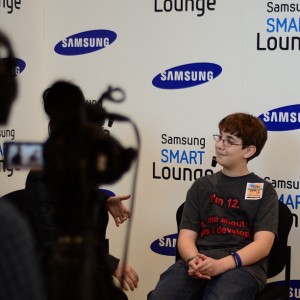 We’re hearing about more and more kidpreneurs and teenpreneurs. There was a 14-year-old who won Cincinnati’s most recent Startup Weekend. Another 14-year-old won Tampa’s most recent Startup Weekend as well.
We’re hearing about more and more kidpreneurs and teenpreneurs. There was a 14-year-old who won Cincinnati’s most recent Startup Weekend. Another 14-year-old won Tampa’s most recent Startup Weekend as well.
Ethan Duggan may not be the winner of a recent Startup Weekend, but he is an app developer and startup founder. His app “LazyHusband” launched at SXSW this year in Austin, Texas.
Ethan is growing up in the Las Vegas startup community, VegasTech for those in the know. His father Rick Duggan, is the cofounder of vegasstartups.com. The elder Duggan is also “coach,” with the younger Duggan preferring the keyboard and the app store to the baseball diamond or the football field.
The young but witty tween, knows a thing or two about apps, launching, startups, founding, and entrepreneurship. He also knows about monetization. When asked about monetizing his app, he told Vegasstartups.com’s John Lynn “$0.99 per download…Coder’s gotta eat.”
Lynn reports that down in Austin during SXSW, the young Duggan scored over 10 interviews and several high profile posts including one by Brad Feld, and another from GigaOM that ended up on CNN Money. Not too shabby for a member of the VegasTech community that couldn’t even get into the legendary VegasTech party. No worries though. The elder Duggan and the VegasTech community made sure Ethan could join the party via FaceTime. (How 2013 is that?)
Now father and son are going to host a talk at SXSW V2V next month in Las Vegas. They’ll be talking about how Ethan overcame stereotypes of proper childhood activities. They’ll also talk about how Rick Duggan is his “coach,” the app Ethan has created, and how you’re Never Too Young.
You can still purchase passes for SXSW V2V here. and sign up for Duggan’s session here.
Nibletz will be on the ground in Vegas for SXSW V2V, with your help. We’ve got great sponsorship opportunities here where you can get your startup, or startup support organization in front of millions at the most high profile startup event of the summer.
Ethan Duggan image: vegasstartups.com
Do You Want to Build a Startup — Or a Small Business?
 A couple months ago, I officially left my rapidly growing, profitable small business to launch a tech startup with a huge vision and zero salaries. Why did I do this? For me, it came down to the huge differences between a small business and a startup.
A couple months ago, I officially left my rapidly growing, profitable small business to launch a tech startup with a huge vision and zero salaries. Why did I do this? For me, it came down to the huge differences between a small business and a startup.
First off, the biggest difference between these two company types is in their top objectives. Small businesses are driven by profitability and stable long-term value, while startups are focused on top-end revenue and growth potential. Steve Blank’s three-minute definition provides great insight.
Earlier this year, I also got the opportunity to meet Mark Cuban, Kevin Plank, and Scott Case, who asked me a classic question with a special motive: “What do you want out of your life in five years?” I knew how Cuban and Plank had made eight-figure companies in their twenties, so I said, “Thirty million dollars,” thinking it would impress them. Instead, Plank said, “That’s a terrible goal!”
That remains the best piece of business advice I have ever gotten. Instead of focusing on great products and huge customer bases, I was too focused on dollar amounts — a small-business mentality instead of a startup mentality. I spent the rest of the weekend working with Case on new business models and products, and left these meetings with a grand new business idea.
My startup journey led me to launch LabDoor. LabDoor provides report cards for your medicine cabinet. Products are graded based on safety, efficacy, and price. Behind the scenes, technical experts analyze top FDA, clinical and independent lab data that informs the product safety apps. Building this startup has been the perfect opportunity to continue my obsession with science, while greatly expanding the amount of people that will benefit from this research.
To be clear, there is nothing wrong with starting your entrepreneurial career with a small business. Building a solid financial base will help create a longer personal financial runway for future startup ventures. Also, establishing a successful small business can build credibility and networks through the business community that will be hugely valuable when launching a startup that requires outside angel and VC investments. But while you do that, be careful not to get too comfortable with a steady paycheck.
How do you decide which one is for you? First, ask yourself, what is my tolerance for risk? And what is my tolerance for failure? Because no matter where you are in your life, it is a great exercise to stop everything and visualize your absolute top-end potential. It’s the kind of brainstorming you did as a kid, when you imagined being the President or, even better, an astronaut.
Then, start by deciding the biggest problem in the world that you want to solve. Develop your ideal solution to this problem, and then invite your trusted friends and family to poke holes in it. Iterate until you’ve got an awesome idea. If you can build a great team around your awesome solution, now you can stretch one foot into the world of startups.
Finally, determine your top objective. Is your long-term goal to build a nest egg or make a dent in the universe?
What do you really want out of your life in five years?
Neil Thanedar is the founder and CEO of LabDoor, a mobile health startup providing consumer-focused product safety ratings. At 24, Neil is the visionary and scientific mind behind a company seeking to replace the FDA and Big Pharma as our top sources of safety information about pharmaceuticals, supplements, and cosmetics.
The Young Entrepreneur Council (YEC) is an invite-only nonprofit organization comprised of the world’s most promising young entrepreneurs. In partnership with Citi, the YEC recently launched #StartupLab, a free virtual mentorship program that helps millions of entrepreneurs start and grow businesses via live video chats, an expert content library and email lessons.
Check out our interview with Neil Thanedar here.
Stopped.At Launches In Super-Super-Beta
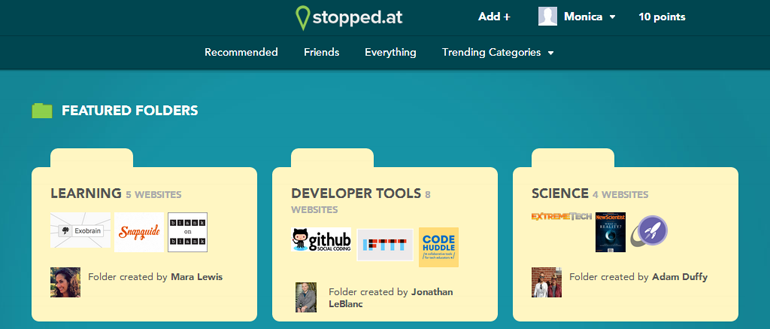 As the Entrepreneur-In-Residence of the new Upstart Accelerator in Memphis, Mara Lewis has spent the last week telling women to just do it. Women have to fight perfectionism, and if they try to make a product perfect before it launches, it’ll never launch.
As the Entrepreneur-In-Residence of the new Upstart Accelerator in Memphis, Mara Lewis has spent the last week telling women to just do it. Women have to fight perfectionism, and if they try to make a product perfect before it launches, it’ll never launch.
“You iterate. You put it out there. It can’t be pretty. If you wait until it’s perfect, you’ve waited too long.”
Lewis’s co-founders back in California were shocked when she took her own advice and made the announcement about their own product: Launch it. Put it live.
And that will forever be the story of stopped.at’s launch into the world. But, of course, it really isn’t the beginning. The beginning happened two years ago when Lewis and her team pivoted their old “Foursquare for the Web” site and began formulating stopped.at.
In the last two years, they have perfected an algorithm similar to Pandora. A user signs up for stopped.at, drags the bookmarklet to their browser, and goes about their business. As they use the web, they “check in” on each site via the bookmarklet. Over time, stopped.at’s algorithm will begin to read the traits of the websites a user visits. Then, it suggests new sites, apps, or services the user might be interested in.
Stopped.at has all the features we love about social sites. You can connect it with your Facebook or Twitter account and you can follow friends. There’s also a rewards system. For each task you do, you earn rewards, which you can then redeem for prizes.
They also have “folders,” similar to boards on Pinterest. Using the folders it’s easy to create collections of the websites, apps, and services you use every day. Then your friends can browse your folders and discover their next must-have app or website. This feature is the one stopped.at’s team is most interested in testing during beta. They want to know if and how people will use them and if they are a good value for the site.
Right now stopped.at is only available on the web. “One regret is,” Lewis admitted with a sigh, “at the time, I wish we had done mobile-first. But, we know it, and we recognize it, and it’s top of our priority list.” Since more than half of American adults use their smartphones to browse the Internet, stopped.at will probably see a lot of growth when they launch on mobile.
The team hopes to launch out of its “super-super-beta” at the end of August, and the goal is to have 50,000 monthly users by October.
Lewis has been at the entrepreneurial game for a long time. This is her third company, and this version of stopped.at has been in production for 2 years. Kyle ran into Lewis during SXSW this year, where she pitched in the Dolphin Tank.
Those of us in the tech world could find stopped.at to be the perfect engine to discovering the best apps and websites out there. Join the public beta and let the team know what you think.
Jacksonville Startup Path.To Finds The Path.To Startup Failure, Shares Ways to Avoid It
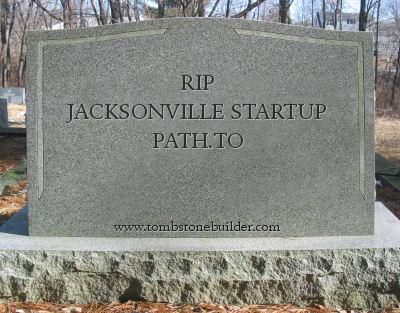 “Failing gracefully.” That’s a topic that comes up a lot in the startup world. We are all too familiar with the failure rate of startups: depending on who you ask, 70-80% of startups fail. On Tuesday we found out that Jacksonville startup path.to will be shutting down on July 19th.
“Failing gracefully.” That’s a topic that comes up a lot in the startup world. We are all too familiar with the failure rate of startups: depending on who you ask, 70-80% of startups fail. On Tuesday we found out that Jacksonville startup path.to will be shutting down on July 19th.
Almost a year ago we interviewed path.to’s CEO Darren Bounds after reporting the previous month that they had expanded their “e-harmony for jobs” startup to include Chicago, Boston, and NYC. For a while everything looked great for path.to. They were rewriting the boring old job search platform and making it more intuitive with algorithms and indepth profiles.
Not only that, but the team is incredible. We met most of them just a few months ago during Jacksonville’s OneSpark festival. A few of the Path.to team members were helping music discovery startup Aurora while others were helping social event tracking startup #eventhash. During the event, organizer Elton Rivas told us that the path.to team were very active in Jacksonville.
“Failing sucks – especially when it comes to your startup. It’s like being kicked hard in the shins right after being dumped, all while standing in the pouring rain with no cabs in sight, only to have a huge truck drive by and splash mud all over you,” path.to community manager Jill Felska wrote on the company’s blog.
What happens next for the team? Well naturally they’ll continue being innovators, entrepreneurs, and members of Jacksonville’s thriving statup scene. Specifically though, Fileska reports that many of the team will continue innovating in the hiring space and making it a happier space by working at Ignite, a job industry idea incubator also based in Jacksonville.
While the ride is officially over tomorrow, the path.to team shared these six valuable lessons they learned during the two years they were building path.to.
1) Don’t wait to solidify your monetization strategy.
“A ‘build it and they will come’ mentality has taken over the startup space. And yes, we were included in that camp. The problem is, it rarely works that way.
We started out with the strong belief that if we could build up a large, impressive user base, that the customers would follow. Unfortunately, we were wrong. We underestimated the amount of education that would be needed to sell our product – and then were very slow to give it the sales attention it really needed.
Monetization can’t be an afterthought when it comes to startups. Shiny products are great only if they’re solving a real problem that customers will pay for.” – Pete Cochrane, President
2) Technology alone isn’t the solution.
“When the product isn’t succeeding like you expect it to, working to make sure you are providing the core service to the customer is more important than continually adding features, optimizing site-speed, and conversion funnels. Perfecting the tech stuff is fun for some of us, but it is only worthwhile if it adds value to a service that people are finding useful.” – Charlie Cauthen, Technical Architect
3) Two-sided markets are a bitch.
“Building a two-sided market is hard. Really, really hard. If I had a do-over, I would start in just one or two key cities, then wouldn’t expand past them until we had built a strong community of both job seekers and businesses who saw value in our product. Becoming a go-to product or service in your launch city not only validates your idea, but also helps drive engagement in future cities.” – Jill Felska, Chief Community Officer
4) Build for the customers you already have.
“We spent a lot of our time trying to make Path.To better by adding new features, adjusting our pricing strategy and trying to make it available to as many people as possible. While important, it’s the existing customers that really matter. If you remember to focus and appreciate the users that you have, they’ll do the work of sending more people your way.” – Kristin Gattis, Path.To People Person
5) Team communication and trust is key.
“Communication is possibly your most important organizational asset. You can have the best team of engineers and designers in the world, but it means nothing if you can’t work together and solve problems. Poor communication drives down morale and can seed resentment that persists until the issue is resolved.
Learning to surface and resolve issues quickly was one of the most important lessons we learned throughout this process. While we could not identify and resolve every problem, creating an environment of open communication and feedback was crucial.
Just as you have processes to monitor the health of your product and servers, someone in your organization should also to pay attention to the the human aspect of the product.” – Joey Marchy, Project Manager
6) Test, test, test…and then learn to let go.
“The biggest thing I learned throughout the process is to test your product’s efficacy as often as possible. Constantly ask yourself whether you’re really solving someone’s problem at the core or if you’re just making current processes slightly better. Accepting that something isn’t working and changing course is more important than getting it right the first time.” – Dennis Eusebio, UX/UI Designer
Hindsight certainly is 20/20 isn’t it? The funny thing is, these lessons aren’t breaking news. They’ve all been written about before.
The problem is that it’s hard to absorb them and look critically at your business when you’re in the trenches. When things are getting done and moving along everyday.
If our team was to challenge you to just one thing, it would be this: take a step back and really look at what you’re building. What advice from mentors, articles, and your customers could impact your business for the better today? It may just save you the trouble of closing your doors someday down the road. We truly hope it does.
OneSpark was one of the biggest startup events we’ve ever seen, check out our coverage here.
Employee #1 Monica Selby Gets It Done
You may have noticed that my grammar, spelling, and story flow have improved over the last two months.
First, thank you.
Second, that’s not by accident.
As an entrepreneur with two successful exits under my belt, I’ve always been a bit headstrong. I’ve also, for the most part, been a one man show. On my previous blog, we had writers, but no one above that or between me and the writers.
However, as Nibletz continued to grow I realized two things: I couldn’t do it all by myself, and people actually wanted to help me.
Most of you know Nick Tippmann joined me on the founding team late last year.
Well two months ago, we got our “employee #1.” This is a huge milestone and a celebration of any startup’s growth. For us though, we didn’t just got an employee #1. We got a bad ass startup chick, like a boss.
Monica Selby has been writing since the 2nd grade. She was the girl that was always writing stories and organizing writing clubs in middle school with her friends. Even while she was in the “real” work force, writing was always a passion for her, and 3-4 years ago she started looking at writing as a serious career path again.
I met Monica at the Upstart 48 Hour Launch in Memphis, where she had pitched her own startup. Unfortunately her startup wasn’t picked, but rather than go home, she spent the entire weekend helping Danielle Inez and Pink Robin Avenue. Inez won the 48 hour launch competition. Monica continued to stick with it, and with Inez, helping her with her Everywhere Else: The Startup Conference booth.
Monica stayed involved with LaunchMemphis (now Start Co), the organization and startup community in Memphis. She had first become aware of LaunchMemphis through her family friend (and our investor*) Patrick Woods. Monica originally thought Patrick was crazy when he asked her if she ever had business ideas of her own. As I prepared this story, Monica told me how she got involved:
Years ago Patrick encouraged me to let him know if I ever had a business idea. At the time, I had 3 kids under 5, so the last thing I was thinking about was starting a business. But, I got involved with some education stuff here in Memphis and had an idea for a education accelerator for teachers. So, Patrick put me in touch with Eric [Mathews, co-president of LaunchMemphis]. I very quickly learned that idea wouldn’t work in this particular educational climate, but I was hooked into the startup scene here in Memphis.
Monica’s title at Nibletz Media Inc is “Managing Editor.” But, like at any startup, that means she wears a ton of hats. She keeps our team organized; she makes sure Nick and I don’t kill each other; she works to grow her personal networks to help create new content and new content categories. Monica is also an integral part of planning next year’s Everywhere Else: The Startup Conference in Memphis and something else really big being announced next week.
On Monica’s personal blog she writes about issues important to her and her audience, including entrepreneurship, women in entrepreneurship, working women, and of course the coveted work-life balance. With 3 boys–a 7-year-old and 2 5-year-olds–that issue definitely hits home. Monica’s husband Austin is a high school teacher and cross country/track coach, which makes “normal” afternoons nonexistent in the Selby house.
Even with all this going on in her life, Monica is dedicated to Nibletz and the Nibletz mission, spending late nights and weekend hours working on ideas, compiling stories, and making new friends in the startup world. Monica has some exciting ideas she’ll be debuting soon, including a contributor network and several regular series. Make sure to check out her first investor spotlight with Carla Valdes.
So, we at Nibletz are excited to have Monica on board. Reach out and say hi through email (monica@nibletz.com) or on Twitter.


